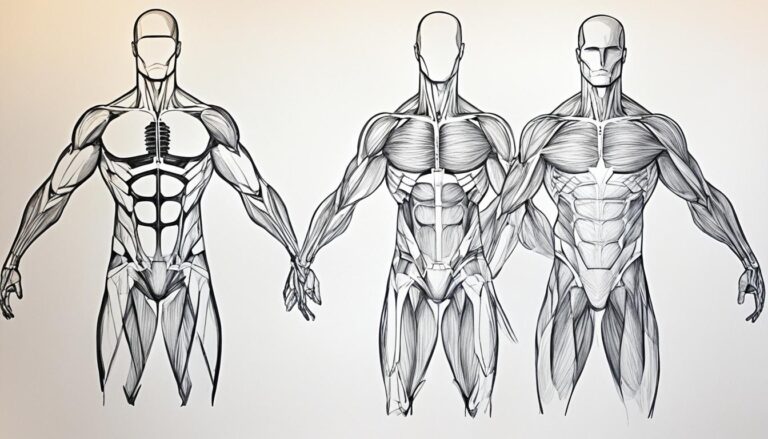How much weight is noticeable?
Have you ever wondered how much weight you need to lose or gain for it to be noticeable to others? Researchers have conducted studies to determine the minimum amount of weight change needed for people to notice a difference in appearance. The findings reveal that the face is particularly sensitive to weight fluctuations and can provide valuable information about overall health.
According to the research, a change in BMI of 1.33 points is required for a noticeable weight change on the face. This is equivalent to approximately 8-9 pounds for the average woman and man. However, it’s important to note that simply being noticed doesn’t necessarily make someone more attractive. To be perceived as more appealing, a BMI decrease of about 2.5 points is necessary, which translates to approximately 14 pounds for women and 18 pounds for men.
Key Takeaways:
- A weight change of approximately 8-9 pounds is required for people to notice a difference in appearance.
- A decrease in BMI of about 1.33 points is needed for a noticeable weight change on the face.
- To be perceived as more attractive, a BMI decrease of about 2.5 points is necessary.
- Weight loss on the face can provide information about overall health.
- Simply being noticed doesn’t necessarily make someone more appealing.
The Impact of Weight Change on Perception
Weight change has a significant effect on how others perceive an individual. Research indicates that a decrease in Body Mass Index (BMI) is the threshold at which weight loss becomes visible in the face. To change perceived attractiveness, women require a BMI shift of 5.24, while men need a shift of 5.7. This roughly translates to a weight loss of approximately 13.9 pounds for women and 18.1 pounds for men.
These findings highlight the importance of considering both weight change and the perception of attractiveness when setting weight loss goals. Losing weight within the range mentioned above can significantly impact how others view your appearance and attractiveness.
“Weight change affects not only physical appearance but also how others perceive an individual. It is essential to understand the weight difference perception and strive to achieve a healthy weight range to project a positive image to others.” – Dr. Emily Turner, Weight Perception Expert
Understanding the relationship between weight perception and weight difference perception is crucial for individuals seeking to make changes to their appearance and overall health. By knowing the approximate weight loss required to produce noticeable changes, it becomes easier to set realistic and achievable goals.
Evidence Supporting the Impact of Weight Change on Perception
A research study conducted by the University of Health Sciences demonstrated the direct correlation between weight change and perception. The study participants were asked to rate the attractiveness of individuals before and after weight loss. The results showed a considerable increase in perceived attractiveness when the weight loss reached the mentioned BMI shifts for both men and women.
- Weight loss threshold for noticeable change in facial appearance: BMI decrease of 2.93
- Weight loss threshold for change in perceived attractiveness for women: BMI shift of 5.24
- Weight loss threshold for change in perceived attractiveness for men: BMI shift of 5.7
These findings not only provide valuable insights into weight perception but also underscore the importance of considering weight difference perception when embarking on a weight loss journey.
The timeline of weight loss
Weight loss is a gradual process that requires patience and perseverance. When embarking on a weight loss journey, it’s important to understand the timeline of this transformative process. Let’s delve into the stages of weight loss and how long it takes for others to notice your progress.
The Initial Drop on the Scale
As you begin your weight loss journey, you may notice a significant drop on the scale in the initial stages. This initial decrease in weight is often attributed to the loss of glycogen stores and excess fluid in the body. While this drop can be encouraging, it’s essential to remember that it doesn’t necessarily represent true fat loss.
Utilizing Stored Fat for Energy
True weight loss occurs when the body starts utilizing stored fat for energy. This process takes time and depends on various factors such as body type, starting weight, height, and genetics. While some individuals may experience noticeable weight loss within a few weeks, others may take longer to see visible changes.
The Amount of Weight Lost Before Others Notice
On average, people tend to notice a weight loss of around 10% of their starting weight. However, it’s important to note that this is just an average and can vary from person to person. Factors such as body type, starting weight, height, and genetics can influence how quickly your weight loss becomes noticeable to others.
Your Personal Weight Loss Timeline
It’s important to remember that your weight loss journey is unique to you. Your personal timeline will depend on various factors and may differ from others. Instead of comparing yourself to others, focus on your own progress and celebrate every milestone along the way.
Embrace the journey, stay dedicated to your goals, and enjoy the positive changes that come with a healthier lifestyle. Your hard work will pay off, and others will start to notice your weight loss in due time.
Factors Affecting the Visibility of Weight Loss
When it comes to weight loss, several factors can influence how quickly changes become noticeable. Understanding these factors can help you set realistic expectations and stay motivated on your weight loss journey.
Starting Weight and Body Type
Your starting weight and body type play a significant role in how quickly weight loss becomes visible. Generally, larger bodies may require more weight loss for noticeable changes compared to smaller bodies. This is because fat distribution can vary, and excess weight may be distributed differently in different individuals.
Skin Elasticity
Skin elasticity, which refers to the ability of the skin to stretch and return to its original shape, can also impact how quickly weight loss is observed. Younger individuals tend to have higher skin elasticity, allowing their skin to bounce back more easily after weight loss. Conversely, as we age, our skin loses some of its elasticity, which may make it take longer for changes to become visible.
Height and Perception of Weight Loss
Height can affect the perception of weight loss. Shorter individuals may appear to have larger changes in their body composition even with the same amount of weight loss compared to taller individuals. This is because a smaller frame and less overall body mass can make weight loss more apparent.
Genetics, Medications, and Medical Conditions
Genetics, medications, and underlying medical conditions can also impact weight loss and how quickly its effects are visible. Genetic factors can influence the rate at which your body metabolizes and stores fat. Medications such as corticosteroids or certain antidepressants may cause weight gain or make it more challenging to lose weight. Medical conditions like hypothyroidism or polycystic ovary syndrome (PCOS) can also affect weight loss.
Understanding these factors can help you manage your expectations and realize that weight loss is not solely a result of diet and exercise. It’s essential to work closely with healthcare professionals and focus on overall well-being rather than solely relying on visible changes as an indicator of progress.

| Factors | Impact on Visibility of Weight Loss |
|---|---|
| Starting Weight and Body Type | May require more weight loss for noticeable changes, larger bodies may take longer to show visible progress |
| Skin Elasticity | Higher elasticity contributes to quicker visible changes, while decreased elasticity may delay the visibility of weight loss |
| Height and Perception | Shorter individuals may experience more visible changes with the same weight loss compared to taller individuals |
| Genetics, Medications, and Medical Conditions | Can impact weight loss rate and visibility, as well as overall progress on the weight loss journey |
Other Ways to Notice Weight Loss
Weight loss is not only about changes in body weight and appearance. There are other non-scale victories and signs of weight loss that indicate progress towards a healthier lifestyle.
Improved Fitness
One significant indicator of weight loss is improved fitness levels. As you lose weight, your body becomes more efficient at physical activities, and you may notice increased stamina and endurance. This improvement can be seen in various forms, such as running longer distances, lifting heavier weights, or completing workouts with less fatigue.
Increased Energy Levels
Another positive sign of weight loss is increased energy levels. Losing excess weight can alleviate the strain on your body, allowing you to feel more energized throughout the day. You may notice a decrease in fatigue and find it easier to engage in daily activities and tasks.
Reduced Breathlessness
If you previously experienced breathlessness during physical activities or even at rest, weight loss can help alleviate this symptom. As your fitness and overall health improve, you may notice that you can engage in activities without becoming breathless, leading to a greater sense of well-being.
Decreased Pain
Weight loss can also contribute to a reduction in chronic pain, especially in weight-bearing joints such as the knees and hips. As you shed excess weight, the pressure on these joints decreases, resulting in less discomfort and improved mobility.
Aside from these non-scale victories, there are other signs of weight loss to look out for:
- Changes in waist size
- Ability to perform physical tasks more easily
- Improvements in overall well-being
Remember, weight loss is not solely about the numbers on the scale. It’s about adopting healthier habits and enjoying the many benefits of a healthier lifestyle.
Individual experiences and timelines
The timeline for noticing weight loss varies for each individual. Factors such as starting weight, body type, height, genetics, and health conditions all contribute to the rate at which changes become visible. It’s important to focus on your own personal progress rather than comparing yourself to others. Your weight loss journey is unique, and your experience will be different from anyone else’s.
Celebrate small milestones and non-scale victories along the way, as these are valuable indicators of progress. Remember that weight loss is not just about the numbers on the scale, but also about adopting healthier habits and enjoying the benefits of a healthier lifestyle.
Factors Affecting Weight Loss Timelines
Several factors can influence how quickly changes in weight become noticeable:
- Starting weight: A higher starting weight may require more significant weight loss for visible changes compared to a lower starting weight.
- Body type: Different body types may have different distributions of fat, which can affect how weight loss is perceived.
- Height: Height can play a role in how weight loss is visually perceived. Shorter individuals may appear to have a larger change in weight even with the same amount of weight loss as taller individuals.
- Genetics: Genetic factors can influence the rate at which weight loss occurs and how noticeable the changes are.
- Health conditions: Certain health conditions can affect weight loss and the visibility of its effects.
By understanding and acknowledging these factors, you can have a better understanding of your personal weight loss timeline and set realistic expectations for yourself.
Personal Progress and Non-Scale Victories
While tracking weight loss progress on the scale is important, it’s also essential to recognize and celebrate non-scale victories. These are the positive changes that may not be directly related to numbers on the scale, but indicate progress and improvements in your overall well-being. Here are some examples of non-scale victories:
“I feel more energized throughout the day.”
“I can now fit into clothes that were previously too tight.”
“I can climb the stairs without getting out of breath.”
“I have more confidence in myself and my abilities.”
Remember that your weight loss journey is about more than just a number. It’s about becoming healthier and happier. By focusing on your personal progress and celebrating your own achievements, you’ll stay motivated and continue toward your goals.
| Factors | Impact on Weight Loss Timelines |
|---|---|
| Starting weight | A higher starting weight may require more significant weight loss for visible changes compared to a lower starting weight. |
| Body type | Different body types may have different distributions of fat, which can affect how weight loss is perceived. |
| Height | Taller individuals may appear to have a smaller visible change in weight compared to shorter individuals with the same amount of weight loss. |
| Genetics | Genetic factors can influence the rate at which weight loss occurs and how noticeable the changes are. |
| Health conditions | Certain health conditions can affect weight loss and the visibility of its effects. |

Conclusion
Based on research, weight loss becomes noticeable when there is a decrease of approximately 10% of your starting weight. However, it’s important to remember that the visibility and timeline of weight loss can vary for each individual. Factors such as body type, starting weight, height, genetics, and overall health can influence how quickly changes become apparent. It’s not just about the numbers on the scale, but also about celebrating non-scale victories and improvements in fitness, energy levels, and overall well-being.
Weight loss is a personal journey, and everyone’s experience will be unique. It’s crucial to stay focused on your goals and not compare yourself to others. Embrace the positive changes that come with a healthier lifestyle, and celebrate the progress you make along the way. Remember, true success lies not only in the numbers but in the overall improvement of your physical and mental well-being. Keep up the great work on your weight loss journey, and enjoy the benefits of a healthier, happier you!
So, as you continue your weight loss journey, be patient, stay motivated, and give yourself credit for every step you take towards a healthier lifestyle. The changes may not always be immediately visible, but with consistency and commitment, you will reach your goals. Remember, weight loss is about more than just appearance; it’s about improving your overall health and well-being. Keep pushing forward, and celebrate every milestone along the way. By making small, sustainable changes in your habits and embracing a positive mindset, you can achieve long-term success in your weight loss journey.
FAQ
How much weight is noticeable?
Researchers have found that a change in BMI of 1.33 points, which is equivalent to approximately 8-9 pounds for the average woman and man, is needed for a weight change to be noticeable on the face. However, to be perceived as more appealing, a BMI decrease of about 2.5 points, or approximately 14 pounds for women and 18 pounds for men, is required.
How does weight change impact perception?
Weight change affects how others perceive an individual. Researchers have determined that a decrease in BMI of 2.93 is the threshold at which weight loss becomes visible in the face. For women, a BMI shift of 5.24 is needed to change perceived attractiveness, while for men, a shift of 5.7 is required. This translates to approximately 13.9 pounds for women and 18.1 pounds for men.
What is the timeline for noticing weight loss?
The timeline for noticing weight loss varies for each individual. Factors such as starting weight, body type, height, genetics, and health conditions all contribute to the rate at which changes become visible. On average, people tend to notice a weight loss of around 10% of their starting weight.
What factors affect the visibility of weight loss?
Several factors can impact how quickly weight loss becomes visible. Starting weight and body type play a role, as a larger body may require more weight loss for noticeable changes compared to a smaller body. Skin elasticity, height, genetics, medications, and medical conditions can also influence the visibility of weight loss.
Besides changes in appearance, how else can weight loss be noticed?
Weight loss can be noticed in various ways beyond changes in body weight and appearance. Non-scale victories, such as improved fitness, increased energy levels, reduced breathlessness, and decreased pain, can indicate progress. Other indicators include changes in waist size, ability to perform physical tasks more easily, and overall improvements in well-being.
Do individual experiences and timelines vary for weight loss?
Yes, the timeline for noticing weight loss and individual experiences can vary. Factors such as starting weight, body type, height, genetics, and health conditions all contribute to the rate at which changes become visible. It’s important to focus on personal progress and celebrate small milestones along the way.
In conclusion, how does weight loss become noticeable?
Weight loss becomes noticeable when there is a decrease of approximately 10% of the starting weight. However, the visibility and timeline of weight loss can be influenced by various factors, including body type, starting weight, height, genetics, and overall health. Non-scale victories and improvements in fitness, energy levels, and well-being should also be celebrated as signs of progress.






